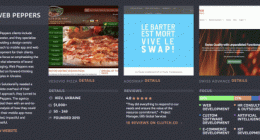If there was a competition for the best PHP environment, the Symfony framework would be there with CodeIgniter and Laravel in terms of popularity. Once you start digging into this framework, it’s easy to understand why to use Symfony framework for development.
Not only does Symfony have a cool name, but it is also very flexible. It includes a package and component system that allows us to select the right PHP features or simply use the entire infrastructure.
To ensure applications work properly, the platform also includes built-in testing functionality. In this article, you will find 10 reasons to use the Symfony framework.
Symfony does not restrict your choice, it gives you the freedom to act, but at the same time requires a detailed understanding of how it works and takes responsibility for building the application structure.
What is the framework?
The main task of a framework is to simplify the solution of often-repeated tasks. The use of any framework is associated with some level of “magic” for any programmer. When a programmer starts working with a framework, he uses sample documentation, ready-made recipes. Work on the projects going relatively quickly with the help of the framework. At the same time, some points of framework work may be not so obvious, may be incomprehensible. They are often called “magic”.
The programmer uses the “magic” of the framework, and everything seems to be fine. At a certain point, he feels the lack of standard features of the framework and recipes. When he create own “magic”, he understands how the framework actually works. That’s how he gets to know the framework. There’s no need to be afraid that you don’t understand all the detail of frameworks at once.
What is the Symfony framework
Symfony is a PHP framework on which you can develop complex web applications. The Symfony framework has very powerful functionality, well-thought-out architecture, and a developed community.
Symfony is a high-performance framework written in PHP. The framework is based on a pattern Model-View-Controller. In its architecture is actively used other patterns of object-oriented programming.
Symfony 2 works with at least version 5.3.2 of PHP. It supports multiple databases (MySQL, MariaDB, PostgreSQL, SQLite, other PDO-compatible DBMS are also suitable). Information about the relational database in the project should be linked to the object model using the ORM tool. The basic version of Symfony comes with two ORMs: Propel and Doctrine.
When choosing Symfony, rather than a CMS as a development platform, you should take into account the fact that the speed of creating standard solutions will be lower than the use of ready-made CMS modules. Yes, the modules written on the framework will work faster, will fully comply with business tasks, but still, their development will cost more.
If to compare Symfony with other PHP-frameworks, the picture is as follows
- Symfony and Yii (or Laravel) – in this comparison, Symfony looks a bit “academic”, in some aspects even clever framework. However, if you consider the development of a complex project, the choice in favor of Symfony will be reasonable – “academicity” pays off if the code base grows rapidly.
- Symfony and Zend – Symfony, in comparison with Zend, looks more attractive framework, largely due to the more beautiful architecture. Both frameworks are powerful and flexible enough, but Symfony subjectively looks more understandable and “right” in terms of design.
Symfony2 is successfully used by global companies, including Yahoo!, TED, Dailymotion, BlaBlaCar, Photobucket, eZ Publish, phpBB, Drupal, etc. Still don’t know why to use Symfony for the development of your project? Read below!

10 reasons to use a Symfony framework
Modularity
Modularity is one of the most important features of Symfony. As mentioned above, Symfony is a set of reused and standalone components – bundles. Everything in Symfony is a bundle, everything lives in them – components of the framework kernel and application code too. This architectural solution allows you to build your application very flexibly. Step by step, you’re building your own structure, brick by brick, so your application is no longer a monolithic wall. You don’t have to destroy the entire application to replace a module. The final configuration can be customized to fit your needs. What’s more, you can use individual Symfony components outside the framework.
Special mention should be made of Dependency Injection support in Symfony as one of the main features of the framework. Using DI reduces connectivity and simplifies code testing.
Symfony has many ready-made solutions
There are solutions for a wide variety of tasks, from everyday to exotic. Today there are more than 2500 based bundles, each of which you can connect and use – thanks to the modularity. If for some reason one of the bundles is not suitable, you can replace it with a similar one or write your own. It’s great to be able to reuse ready-made components and third-party libraries and at the same time not be nailed to a particular technology or tool.
Complex framework
Symfony is too complicated. In part, it is – Symfony has a higher entry threshold compared to other PHP frameworks. Accordingly, it takes much more time to master it. Beginners will find it difficult. Here are using the innovative features of the language and the application of design patterns. You need to be prepared for the fact that the study of only Symfony will not be enough. It is necessary to get acquainted with the technologies and tools that go hand in hand with Symfony and allow you to use it as productively as possible: Twig, SwiftMailer, Monolog, PHPUnit, Doctrine, as well as the most popular libraries, such as FOS, Knp, Gedmo.
Deep concept and ideology
Symfony has a built concept and ideology, but it’s important to understand that it doesn’t provide the ready and only right solution when developing a project. The task of building the final application architecture is fully delegated to the developer and remains on his conscience. There are two consequences that resonate with the previous point: an experienced Symfony-developer is more likely to have a deep knowledge of the language in particular and design skills in general. The second, not so cheerful moment: it is more difficult to find competent Symfony-developers, and education of own takes time.
Symfony makes you free
Since the framework is flexible, there are a lot of possibilities to configure it. Configurations and annotations are all ours. In standard delivery of the framework, basic configuration files are already present. However, Symfony developers are not limited to YAML files. To configure an application or parts of it, you can use annotations, configs as XML- or PHP-files. There is no single style, and everyone uses the method that seems most convenient. Of course, for many things, there are recommendations on what to use in a particular situation, but this does not impose additional restrictions on the developers, they are free to make their own choice.
What is this, freedom or chaos? This situation can be turned in any direction. Everything is simple enough. By giving programmers a choice, responsibility is fully placed on them. Obviously, if used indiscriminately, the application will not be of high quality. The right solution would be to agree within the team on the approach to configuring the application and describing the code even before the active development stage starts. Communication is the key to success.
Symfony framework is mostly suitable for large projects
Symfony, if we are talking about a full-stack framework, is good for relatively large projects. Symfony is not the best choice for small projects with a few exceptions. First of all, it can be used if you need to solve relatively typical tasks, and the benefit of a quick start and the use of standard bundles is significant. However, in this case, the choice should be made consciously, weighing all the advantages and problems that may have to be faced. The second exception is the use of Symfony “for growth” from the perspective of project expansion and scalability. In any case, the tool should be chosen based on the tasks.
Strong community
Perhaps this argument can be heard when talking about almost any popular framework or programming language. Everyone is convinced that the community is large, extremely friendly, responsive and ready to do good to every newcomer. As trivial as this may sound, the Symfony community is really big. There are many developers on GitHub and StackOverflow who answer questions (including core and bundle developers). This communication is not one-way, anyone can create pull-requests, make suggestions, create their own bundle. Live communication enthusiasts should note that the community regularly holds conferences, both international and national. Problem-solving is accelerated by the huge community of developers, testers, integrators and other specialists working for its development and improvement.
Excellent documentation
It is impossible not to note the high level of documentation. It is relevant for each version of the framework, describes not only the components but also the most popular bundles. On the official website, you still can find a book on the practical use of Symfony, a list of instructions and best practices for using the framework. To mark the 5th anniversary of the second version of the framework, the creators decided to thoroughly revise the documentation, creating two sections:
- Getting started – a short book on the basics of working with the framework.
- Guides & Tutorials – manuals on specific topics.
Speed
With Symfony, you can solve problems of high complexity and large scale very quickly. Looking at the most diverse benchmarks of PHP frameworks, it becomes clear that Symfony’s performance at a decent level. It is not a favorite framework of programmers in terms of performance, there are faster frameworks. It is important to understand why this happens. You have to pay for everything, and in programming, you often have to pay for the convenience, quality, and speed of development.
Support and financing
Another important point for an open-source project is the support of a commercial company, in this case, SensioLabs. The company offers additional services such as consulting, training, various certifications. This gives additional confidence in terms of project stability, further growth and development of the framework ecosystem. The developer of Symfony, SensioLabs creates and develops a modern PHP framework in accordance with the requirements of modern and sophisticated developers of wide views.

Symfony Framework is a leading technology for developing open source web applications. This is an argument for many of our clients when it comes to creating complex and large web application systems. Our “10 reasons to use Symfony framework” article may convince you.
MVC (Model-View-Controller) is the paradigm on which Symfony is based to accelerate the creation and support of web applications. MVC help avoid code duplication, making this framework a strong tool for solving problems and creating solutions for business.
Web Peppers provide high-quality Symfony development
Web Peppers has spent years qualifying its development team at Symfony to create unique custom solutions that help clients achieve business goals. It is our experience in Symfony that has helped us to write this “10 Reasons To Use Symfony Framework” article.
The combination of experienced professionals (front end and back end developers, project managers, designers, server administrators) and the advanced technologies we specialize in (Symfony, MySQL, jQuery, Zend, JavaScript, HTML5 and many others) ensures that your business needs will be addressed with knowledge, thoroughness, and attention.
Today, e-commerce is a factor that determines the trend in the world of retail sales. The market expects your website to be fast (run fast even under heavy load), intuitive and provide a flawless user experience. Advanced technologies like Symfony2 are designed to achieve these goals.
Web Peppers development team puts its own heart and soul into free mastery of basic mechanisms and is skillfully mastered in Symfony2 like many other technologies.
Tasks that we solve:
- Create complex and functional web products.
- Create high-performance, high-load systems.
With its core developers (key developers of this technology), the current capabilities of PHP, and the overall direction of the project – all this makes development on Symfony as painless as possible for developers, providing work with a reliable code base, sharpened to work on enterprise-level projects. Symfony is the perfect technology for any serious project.
If you’re still not sure, then contact us and our experts at Symfony will be happy to dispel any doubts you may have.










